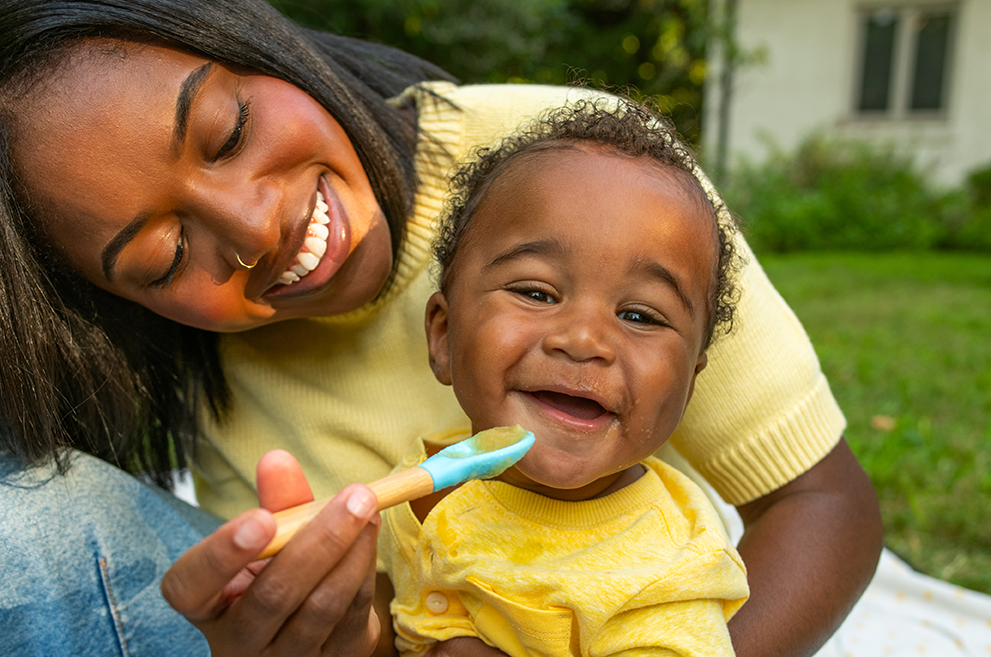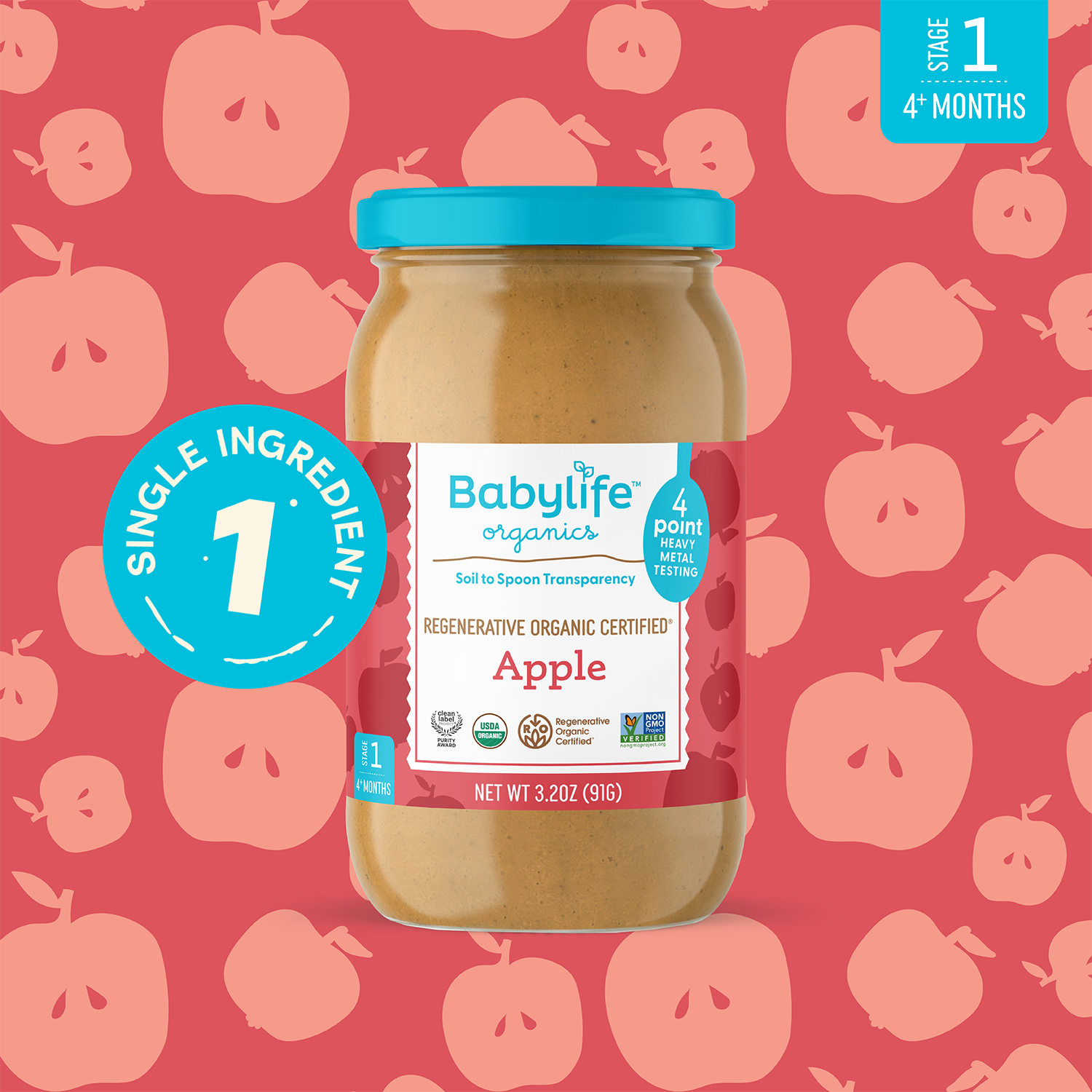More and more, as a parent, you’re attuned to the term ‘heavy metals.’ Maybe you’re curious because you’ve learned about the benefits of limiting them in your own diet. Or you’ve read some of the news about high levels of heavy metals in baby food. It’s been hard to avoid the headlines since 2018, when Consumer Reports found that 33 out of 50 baby foods tested contained unacceptable levels of heavy metals including arsenic, cadmium, lead, and mercury. From 2019-2023 a series of other investigations revealed that toxic levels of heavy metals were in up to 95% of store-bought conventional and organic baby food brands1, and significant levels were found in homemade baby food.
Parents searching for a safer, healthier way to feed their young children are rightfully concerned. It’s something our team at Babylife Organics has been working to remedy for years: While it’s i mpossible to eliminate heavy metals altogether—whether that’s in homemade food or in a manufactured product—we choose to source produce from farms where industrial contamination is minimized and soil health is prioritized. We also committed, from day one, to building a brand that brings complete transparency and clear explanations to parents and caregivers everywhere.
Because heavy metals are essentially unavoidable—according to the American Academy of Pediatrics2, they can get into both conventional and organic food products from soil, water, air or industrial processes—our team has worked tirelessly to figure out a way to mitigate toxic levels in baby food. It is with great pride that we launched the first line of Regenerative Organic Certified ® baby food to be tested at four different stages of the supply chain for arsenic, cadmium, lead, and mercury. We’re the first company to develop a baby food product that comes from cleaner soil and a single-source supply chain that is closely monitored, allowing for stringent testing and monitoring all along the ingredient journey. We’re also the first to provide consumers with per package heavy metal level results, not just benchmarks. This is unprecedented in the market.
How did we do it? Committed to Soil to Spoon Transparency™, we’re sharing the dirt on our proprietary four-point heavy metal testing—how it works and why it’s a superior standard for baby food.
WHAT PARENTS NEED TO KNOW ABOUT HEAVY METALS
In order to grasp the significance of our Soil to Spoon Transparency™ promise, it’s important for caregivers to understand what heavy metals really are and why they matter when it comes to baby’s food. Yes, it feels a little bit like doing your homework (more like taking a college geology course!) but it’s worth it.
On the most basic level, heavy metals are naturally occurring in Earth’s crust. They’re most commonly found in soil. In theory, this could be fairly harmless. But because us humans have a bad habit of meddling with planet Earth, practices like mining, fracking, industrial agriculture and using wastewater for irrigation—generally, pollution—heavy metals can contaminate certain soil and water. And certain plants can absorb those contaminants—arsenic, lead, cadmium and mercury are among the most commonly found in soil, and thereby in food products. Even in organic soil, some plants absorb heavy metals because of contaminated water run-off. Some food, like rice, is particularly efficient at pulling heavy metals from the soil. And some products using rice substitutes such as cassava have recently been reported to have concerning levels of lead in them, according to Consumer Reports
Of course, all of us are then susceptible to consuming heavy metals from our food sources. Most of us have been warned against, for example, consuming too much mercury through fish. However, babies and toddlers are more vulnerable because of their size: the number of calories they consume every day is a larger fraction of their total weight than older children and adults. In the last decade, more than 20 peer-reviewed studies have shown a link between toxic heavy metal exposure and impaired brain function in children.3
WHAT’S CURRENTLY BEING DONE TO REDUCE HEAVY METAL LEVELS AND WHY IT’S STILL NOT ENOUGH
Why are you hearing more about heavy metals in baby food now? First, it’s helpful to understand the history of heavy metal regulation in the United States: Up until a few years ago, the U.S. Food and Drug Administration (FDA) did not have regulatory limits for heavy metals in food products. To date, the FDA has set tolerance levels only for infant rice cereal (for inorganic arsenic), and in 2023 the FDA proposed maximum levels for lead in fruit juice. These regulations are particularly limited when compared to the EU, where baby food has a unique set of legislation that defines acceptable levels for ingredients, additives and contaminants.
In the absence of federal regulation, some baby food brands have taken it upon themselves to advocate for more oversight. Industry-wide concern really began in 2017 when Healthy Babies, Bright Futures published a report about alarming levels of arsenic in baby cereals. In 2018, calls for change reached a fever pitch as unacceptable levels of heavy metals were found in nearly every brand of baby food sampled by a third-party watchdog.
Some companies began to seek certification through the Clean Label Project, a national nonprofit with the mission to bring more transparency to food products, surpassing the minimum regulations required by the FDA. While these measures surpass any others to date, the need for soil testing, stringent, by-batch product testing and not just periodic samples, and publicly shared results of those tests remains to be passed into law and required at an industry level. Here’s a snapshot of the timeline of events since then the inflection point in 2018:
- 2019: The Baby Food Council is established by category leaders along with the Environmental Defense Fund and Healthy Babies, Bright Future (both of which withdraw in 2021)
- 2021: The U.S. House of Representatives Committee on Oversight and Reform’s Subcommittee on Economic and Consumer Policy released a report on baby foods tainted with dangerous levels of arsenic, lead, cadmium and mercury
- 2021: FDA launches “Closer to Zero’, an initiative focused on eliminating heavy metals from baby food with a proposed phased roll out
- 2021:The Baby Food Safety Act was drafted by Congress, establishing maximum levels of heavy metals allowable in infant and toddler food
- 2022: Healthy Baby Bright Futures releases a study on homemade baby food indicating it contains as many heavy metals as store bought
- 2022: Clean Label Project launches itsFirst 1,000 Day Promise certification using elements of the European Union baby food regulations to set maximum heavy metal thresholds
- 2023: California passes Bill 899, a law requiring baby food brands to post heavy metal test results on their website by January, 2025—if the product is tested for a specific toxic element that has a final FDA regulatory limit. These limits have yet to be established.
- 2024: The Baby Food Safety Act of 2024 was introduced in the House of Representatives in December, 2023. It would allow the FDA to enforce scientifically established limits on heavy metals in commercial infant and toddler food. It would also raise standards for food manufacturer testing for contaminants.
Despite all of these efforts and progress, many still feel that not enough is being done to limit the levels of heavy metals in baby food—and common testing practices are not stringent enough. For example, artificial additives and manufacturing processes can alter the end product. This is why our founders were so adamant about developing a new/unprecedented 4-point testing process that assesses heavy metal levels at critical points during production.
HOW BABYLIFE DEVELOPED A TESTING PROCESS AND BETTER TRANSPARENCY
At Babylife Organics, everything we do starts with the soil—the root source of heavy metal contamination. Our founding team knew, from decades of experience, that the farm in Türkiye (Turkey) we chose to partner with was incredibly unique due to their broad assortment of fruits and vegetables. The farm itself is mostly untouched by modernization, and many of our fruits are grown in the wild. Because Babylife has full access and control over the farms—versus other baby food companies that source from different suppliers—we are able to test the raw ingredients and the soil, as well as the finished product.Having this safe, secure, single-point supply chain is a key differentiator in baby food: We grow and harvest all of our ingredients on these farms and blend and package them with the same trusted provider. That means we have a direct line of sight into each stage of production.
But we didn’t stop there—our team worked to develop a 4-point testing process that evaluates levels of arsenic, cadmium, lead and mercury at four critical junctures during the sourcing and production process, adhering to standards set by the European Union Food Safety Policy and The Clean Label Project® First 1000 Days Promise
What makes this extraordinary testing protocol possible? Having full control of the supply chain allows us to test throughout the process from beginning to end: First, we test the soil once a year during each planting season. Second, we test the raw ingredients from each harvest. Then, we test the purees after they’ve been blended, and finally we test the finished product in the pouch or jar.
Babylife Organics works with an independent testing organization that has highly precise equipment. Wevetted a number of different labs and went out of our way to seek one that can test down to among the lowest levels in the industry at 2 parts per billion.In addition, testing at four stages, we can easily identify any problems much earlier in the supply chain (i.e. the raw ingredients and soil) so we can mitigate any issues before moving into production.
As part of our commitment to full transparency, we share the results of testing the finished product with consumers: Babylife Organics is unique in that it provides per package level data and not just benchmarks. We provide a QR code on all of our pouches and jars that gives parents real-time access to lot code testing assurance.
Ensuring that our farms are Regenerative Organic Certified® was another critical step we took in an effort to increase the overall health and safety of our baby food. By adhering to the ROC™ standards, our farmers are dedicated to the best practices for both people and planet, cultivating some of the purest soil on Earth. We continue this practice of clean, pure, and simple throughout the manufacturing process, keeping additives and fillers out of our finished goods.
This wildly complex topic is not an easy challenge to face. By pushing ourselves to set higher standards and follow through–soil to spoon–we aspire to do more than offer a better baby food on shelf: We hope to prove a viable alternative to existing agricultural and supply chain trends at the industry level.






